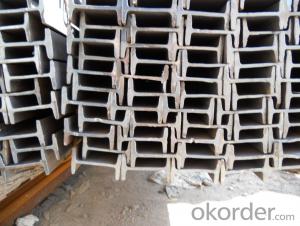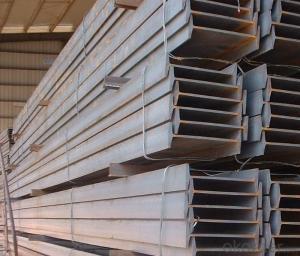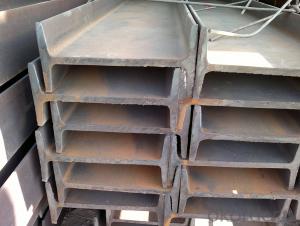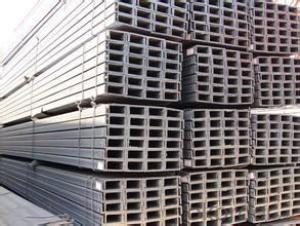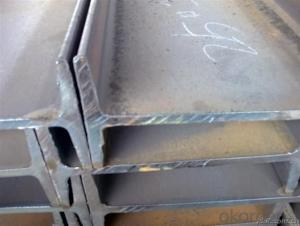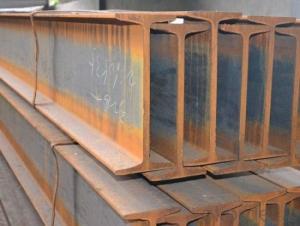European Standard IPE100/IPE120 with High Quality
- Loading Port:
- Tianjin
- Payment Terms:
- TT or LC
- Min Order Qty:
- 25 m.t
- Supply Capability:
- 15000 m.t/month
OKorder Service Pledge
OKorder Financial Service
You Might Also Like
Product Description of European Standard IPE100/IPE120 with High Quality:
Specifications of European Standard IPE100/IPE120 with High Quality:
1.Standard: EN10025
2.Material: S235JR or Equivalent
3.Length: 6m, 12m
4. Size:
| Size(mm) | Mass(Kg/m) |
| 100*55*4.1 | 8.10 |
| 120*64*4.8 | 10.40 |
Usage & Applications of European Standard IPE100/IPE120 with High Quality:
Commercial building structure;
Pre-engineered buildings;
Machinery support structures;
Prefabricated structure;
Medium scale bridges.
Packaging & Delivery of European Standard IPE100/IPE120 with High Quality:
1. Transportation: the goods are delivered by truck from mill to loading port, the maximum quantity can be loaded is around 40MTs by each truck. If the order quantity cannot reach the full truck loaded, the transportation cost per ton will be little higher than full load.
2. With bundles and load in 20 feet/40 feet container, or by bulk cargo, also we could do as customer's request.
3. Marks:
Color mark: There will be color marking on both end of the bundle for the cargo delivered by bulk vessel. That makes it easily to distinguish at the destination port.
Tag mark: There will be tag mark tied up on the bundles. The information usually including supplier logo and name, product name, made in China, shipping marks and other information request by the customer.
If loading by container the marking is not needed, but we will prepare it as customer's request.
FAQ:
Q1: Why buy Materials & Equipment from OKorder.com?
A1: All products offered byOKorder.com are carefully selected from China's most reliable manufacturing enterprises. Through its ISO certifications, OKorder.com adheres to the highest standards and a commitment to supply chain safety and customer satisfaction.
Q2: How do we guarantee the quality of our products?
A2: We have established an advanced quality management system which conducts strict quality tests at every step, from raw materials to the final product. At the same time, we provide extensive follow-up service assurances as required.
Q3: How soon can we receive the product after purchase?
A3: When we receive the advance payment or original LC, we will arrange production. The shipping date is dependent upon the quatity, how many sizes you want and the plan of production, but is typically 1 month to 2 month days from the beginning of production.
Images of European Standard IPE100/IPE120 with High Quality:
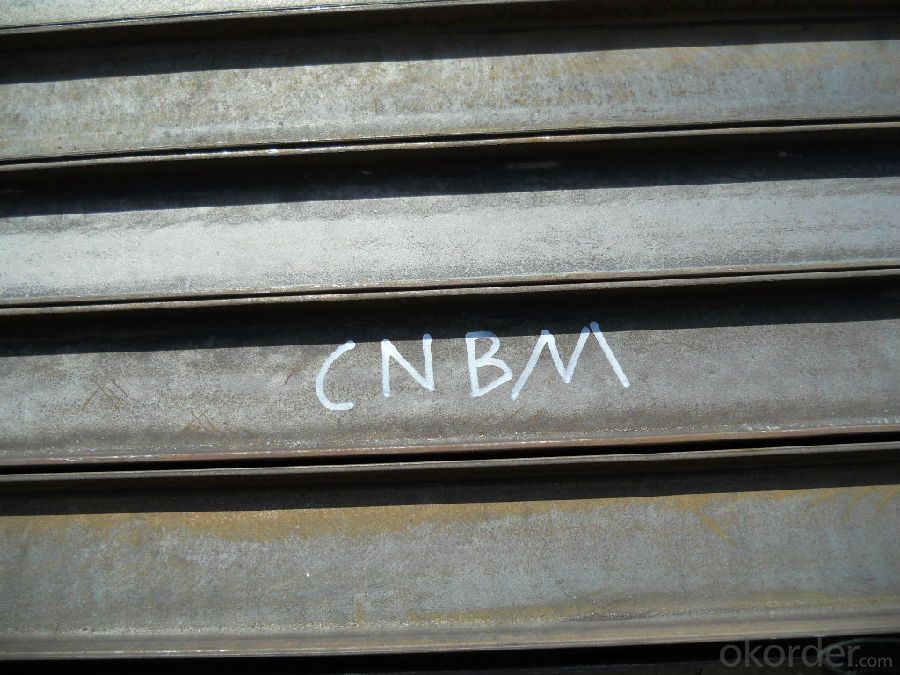
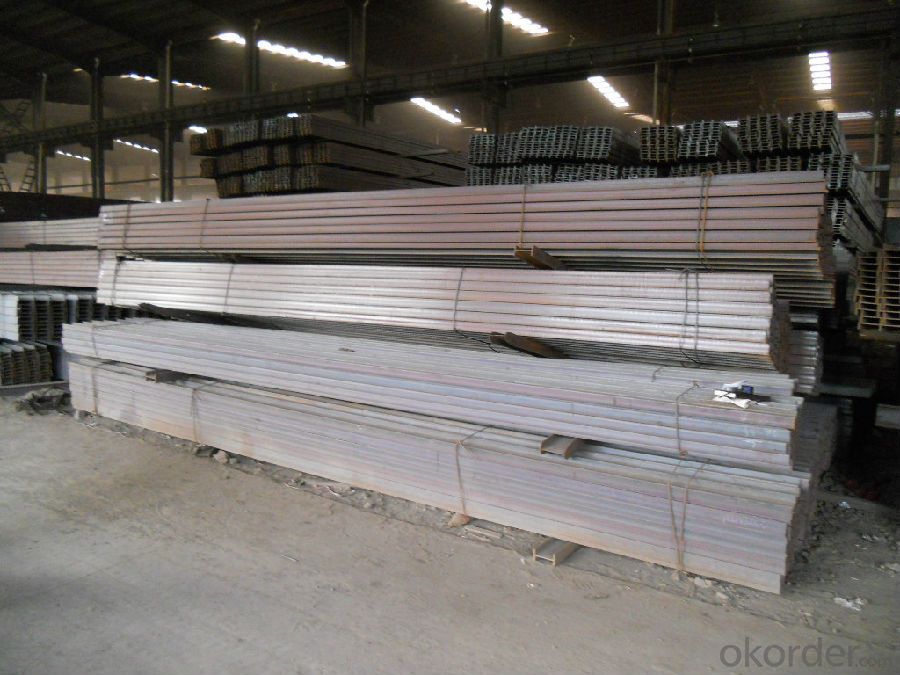
*If you would like to get our price, please inform us the size, standard/material and quantity. Thank you very much for your attention.
- Q:How are steel I-beams used in floor framing?
- Due to their strength and load-bearing capabilities, steel I-beams are commonly employed in floor framing. They carry the weight of the floors and other elements of a building, including walls and the roof. In floor framing, steel I-beams function as primary structural members called joists or girders. They are placed horizontally and span the space between supporting walls or columns, creating a rigid framework capable of sustaining the weight of the floors above. The I-beam shape, resembling the letter "I", offers exceptional strength and rigidity while minimizing the weight of the beam itself. This quality makes steel I-beams well-suited for floor framing as they can withstand heavy loads and evenly distribute them across the span. The I-beams are often arranged parallel to each other, with smaller steel beams known as joists positioned perpendicular to them. These joists are then connected or welded to the I-beams, forming a stable framework capable of supporting the weight of the floor decking, insulation, and other components. Moreover, steel I-beams can serve as support beams for open floor plans or large spans. They can span longer distances without requiring additional support columns or walls, allowing for greater architectural design flexibility. In summary, steel I-beams play a critical role in floor framing by providing strength, stability, and durability to the structure. Their utilization ensures that the floors can safely bear the intended loads and maintain the building's structural integrity.
- Q:What are the different types of steel I-beam connections for beam-to-beam joints?
- There are several different types of steel I-beam connections that can be used for beam-to-beam joints. Some of the most common types include: 1. Welded connections: This involves welding the two beams together at the joint. It provides a strong and rigid connection, but requires skilled labor and can be time-consuming. 2. Bolted connections: This method involves using bolts and nuts to secure the beams together at the joint. It is easier to assemble and disassemble compared to welded connections, but may not provide as much rigidity. 3. Riveted connections: This traditional method involves using rivets to connect the beams. Although it is less commonly used nowadays, it provides a strong and durable connection. 4. Moment connections: These connections are designed to transfer bending moments between the beams. They are typically used in situations where the beams are subjected to heavy loads and require additional support. 5. Shear connections: These connections are designed to transfer shear forces between the beams. They are commonly used in situations where the beams are subjected to lateral loads or wind forces. 6. Slotted connections: This type of connection involves using slots in the beams to allow for adjustability and flexibility. It is often used when precise alignment or adjustment is required. It is important to consider the specific requirements of the project and consult with a structural engineer to determine the most suitable type of steel I-beam connection for beam-to-beam joints. Factors such as load capacity, structural design, and ease of installation should be taken into account when selecting the appropriate connection method.
- Q:What are the different accessories or attachments used with steel I-beams?
- Steel I-beams commonly utilize various accessories and attachments to improve their functionality and structural integrity. Some of these accessories include: 1. Beam clamps, which securely fasten the steel I-beams to other structural elements or support systems. They come in different sizes and designs to accommodate diverse beam sizes and load requirements. 2. Beam connectors, which join multiple steel I-beams together to form a continuous beam. They are particularly useful in long-span applications or when additional strength is necessary. 3. Beam hangers, which suspend the steel I-beams from overhead structures or support systems. They offer a reliable and secure means of supporting the beams, especially in situations with limited space for support columns. 4. Lateral braces, which provide added stability and prevent lateral movement of the steel I-beams. These braces are typically installed at regular intervals along the beam's length and can be either welded or bolted to the beam. 5. End plates, which connect the ends of steel I-beams to other structural elements or support systems. These plates are typically bolted or welded to the beam ends, offering a secure connection capable of withstanding high loads and forces. 6. Cleats, small steel plates that are welded or bolted to the sides of the steel I-beams. Cleats provide additional support and prevent beam twisting or rotation under load. 7. Brackets, which support other components or fixtures attached to the steel I-beams. Brackets can be welded or bolted to the beams and are commonly employed to support equipment, lighting fixtures, or other building systems. These accessories and attachments play a critical role in ensuring the proper installation, support, and functionality of steel I-beams across various construction and structural applications.
- Q:Can steel I-beams be used for underground structures?
- Yes, steel I-beams can be used for underground structures. Steel is a versatile and durable material that can withstand a wide range of environmental conditions, including being buried underground. Steel I-beams are commonly used in the construction industry for their strength and load-bearing capabilities, making them suitable for various applications, including underground structures. When using steel I-beams for underground structures, several factors need to be considered. Firstly, the steel beams should be properly treated and coated to protect them from corrosion caused by moisture and soil chemicals. This can be done through galvanization or applying epoxy coatings. Additionally, proper drainage systems should be in place to prevent water accumulation, which could accelerate corrosion. Steel I-beams can be used in underground structures such as basements, tunnels, underground parking lots, and even underground mining operations. They provide structural support and can handle heavy loads, making them a suitable choice for these applications. Moreover, steel beams can be easily fabricated and customized to meet specific design requirements, offering flexibility in designing underground structures. It is important to note that engineering expertise and careful planning are crucial when using steel I-beams for underground structures. Factors such as soil conditions, water table levels, and the overall design and purpose of the structure need to be considered to ensure the safety and longevity of the underground construction. Consulting with structural engineers and architects experienced in underground construction is highly recommended to ensure the proper and safe use of steel I-beams in these applications.
- Q:Are steel I-beams resistant to chemical exposure?
- Steel I-beams are generally resistant to chemical exposure. However, the level of resistance may vary depending on the specific chemical involved, its concentration, and the duration of exposure. It is important to consult with experts or refer to chemical compatibility charts to ensure proper protection and maintenance of steel I-beams in corrosive environments.
- Q:Are steel I-beams suitable for crane runway beams?
- Indeed, steel I-beams prove to be a fitting option for crane runway beams. These I-beams are frequently utilized in the construction industry and have gained recognition for their robustness and long-lasting nature. Owing to their remarkable load-bearing capacity, they are well-suited for providing the necessary support to withstand the substantial weights typically borne by cranes. Moreover, steel I-beams can be tailor-made to meet the precise requirements of crane runways, encompassing desired dimensions such as length and width. Their resistance to corrosion also renders them highly advantageous for outdoor or industrial settings, where cranes are commonly employed. All in all, steel I-beams emerge as a dependable and apt choice for crane runway beams.
- Q:What are the common maintenance practices for steel I-beams?
- Common maintenance practices for steel I-beams include regular inspection for signs of corrosion or damage, cleaning to remove dirt and debris, applying protective coatings or paints to prevent rusting, and addressing any structural issues promptly through repairs or reinforcement. Additionally, ensuring proper drainage and preventing water accumulation can help prevent corrosion and extend the lifespan of steel I-beams.
- Q:Can I use butt welding to weld steel? What are you asking for? What specifications are you looking for?
- Certainly. The I-beam on the long span single beam crane is welded. Otherwise, more than 20 meters of I-beam in the carrier also has problems.The main requirements is docking two I-beam to try to level up, up and down all around and then find it, in order to avoid deformation.Norm I don't know.Crane manufacturer personnel.
- Q:Can steel I-beams be used for cantilever structures?
- Yes, steel I-beams can be used for cantilever structures. Cantilever structures are designed to have one end anchored or supported while the other end extends outwards, creating an overhang. Steel I-beams are often used in cantilever structures due to their strength, rigidity, and ability to span long distances. The I-shape provides excellent load-bearing capabilities, allowing the beam to support the weight and distribute the load evenly. Additionally, steel I-beams can be easily fabricated and customized to meet specific project requirements, making them a popular choice for cantilever structures in various applications such as bridges, balconies, and building façades.
- Q:Can steel I-beams be used in educational or research facilities?
- Educational or research facilities can indeed incorporate steel I-beams. The reason behind their frequent usage in construction lies in their remarkable strength and durability. By providing structural reinforcement, these beams guarantee stability and safety for various buildings, including educational or research facilities. Furthermore, steel I-beams offer adaptability and customization options to fulfill specific needs, like facilitating heavy loads or spanning large distances. Their versatility renders them ideal for numerous purposes within such facilities. They can support roofs, floors, and walls while also creating open and flexible spaces for laboratories, classrooms, or research areas.
1. Manufacturer Overview |
|
|---|---|
| Location | |
| Year Established | |
| Annual Output Value | |
| Main Markets | |
| Company Certifications | |
2. Manufacturer Certificates |
|
|---|---|
| a) Certification Name | |
| Range | |
| Reference | |
| Validity Period | |
3. Manufacturer Capability |
|
|---|---|
| a)Trade Capacity | |
| Nearest Port | |
| Export Percentage | |
| No.of Employees in Trade Department | |
| Language Spoken: | |
| b)Factory Information | |
| Factory Size: | |
| No. of Production Lines | |
| Contract Manufacturing | |
| Product Price Range | |
Send your message to us
European Standard IPE100/IPE120 with High Quality
- Loading Port:
- Tianjin
- Payment Terms:
- TT or LC
- Min Order Qty:
- 25 m.t
- Supply Capability:
- 15000 m.t/month
OKorder Service Pledge
OKorder Financial Service
Similar products
New products
Hot products
Hot Searches
Related keywords
